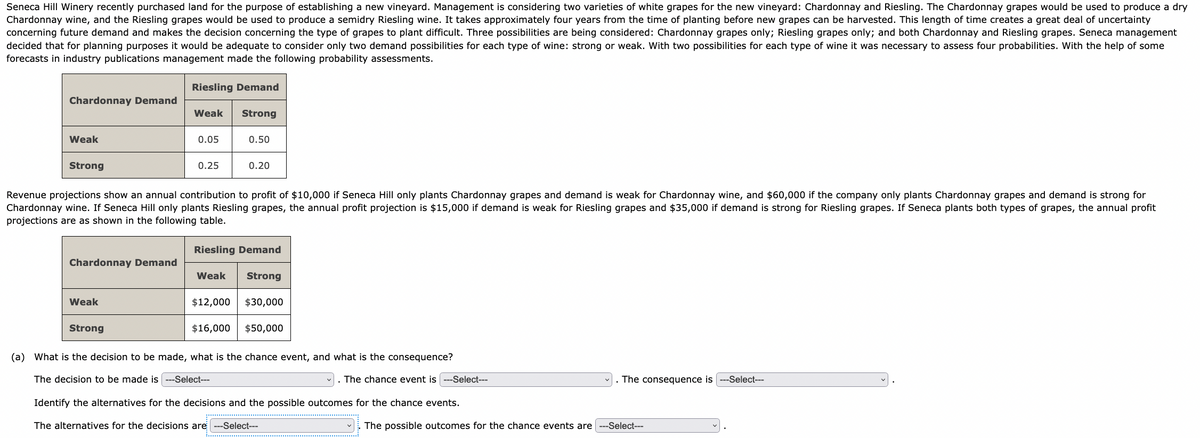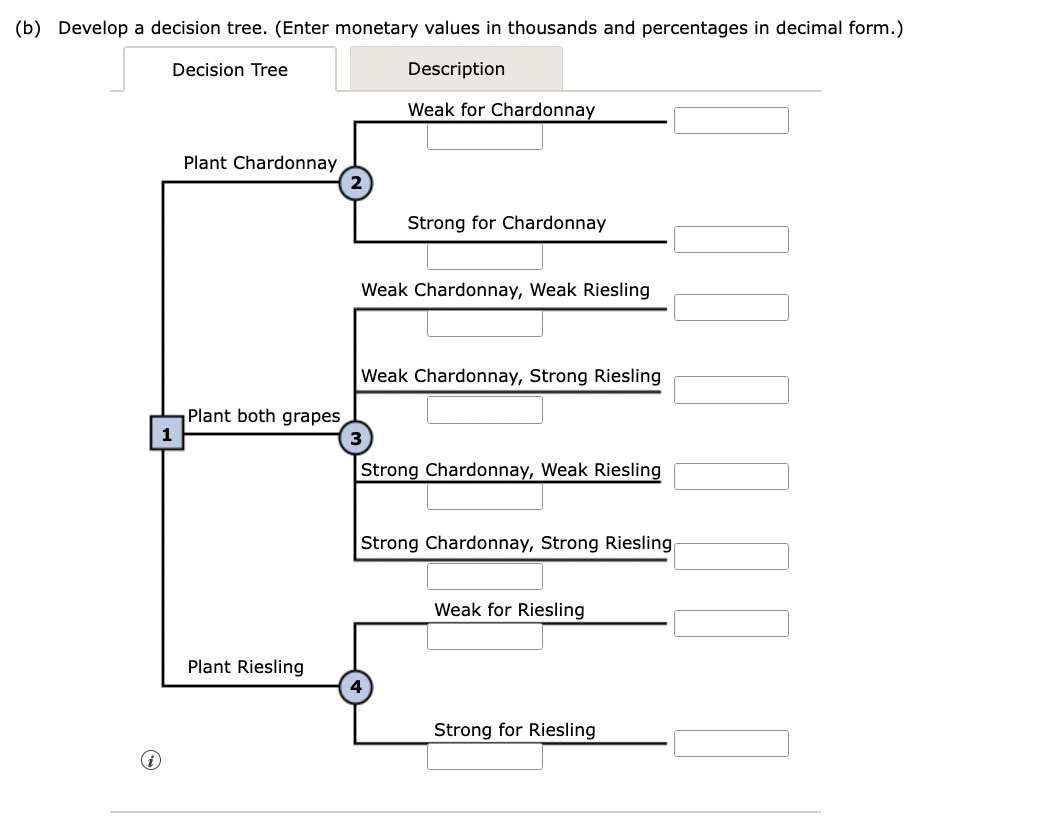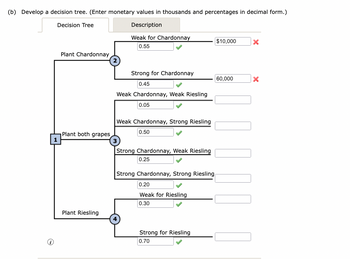Seneca Hill Winery recently purchased land for the purpose of establishing a new vineyard. Management is considering two varieties of white grapes for the new vineyard: Chardonnay and Riesling. The Chardonnay grapes would be used to produce a dry Chardonnay wine, and the Riesling grapes would be used to produce a semidry Riesling wine. It takes approximately four years from the time of planting before new grapes can be harvested. This length of time creates a great deal of uncertainty concerning future demand and makes the decision concerning the type of grapes to plant difficult. Three possibilities are being considered: Chardonnay grapes only; Riesling grapes only; and both Chardonnay and Riesling grapes. Seneca management decided that for planning purposes it would be adequate to consider only two demand possibilities for each type of wine: strong or weak. With two possibilities for each type of wine it was necessary to assess four probabilities. With the help of some forecasts in industry publications management made the following probability assessments. Chardonnay Demand weak Riesling Demand Weak Strong 005 0.50
Seneca Hill Winery recently purchased land for the purpose of establishing a new vineyard. Management is considering two varieties of white grapes for the new vineyard: Chardonnay and Riesling. The Chardonnay grapes would be used to produce a dry Chardonnay wine, and the Riesling grapes would be used to produce a semidry Riesling wine. It takes approximately four years from the time of planting before new grapes can be harvested. This length of time creates a great deal of uncertainty concerning future demand and makes the decision concerning the type of grapes to plant difficult. Three possibilities are being considered: Chardonnay grapes only; Riesling grapes only; and both Chardonnay and Riesling grapes. Seneca management decided that for planning purposes it would be adequate to consider only two demand possibilities for each type of wine: strong or weak. With two possibilities for each type of wine it was necessary to assess four probabilities. With the help of some forecasts in industry publications management made the following probability assessments. Chardonnay Demand weak Riesling Demand Weak Strong 005 0.50
Practical Management Science
6th Edition
ISBN:9781337406659
Author:WINSTON, Wayne L.
Publisher:WINSTON, Wayne L.
Chapter5: Network Models
Section: Chapter Questions
Problem 66P
Related questions
Question
100%

Transcribed Image Text:Seneca Hill Winery recently purchased land for the purpose of establishing a new vineyard. Management is considering two varieties of white grapes for the new vineyard: Chardonnay and Riesling. The Chardonnay grapes would be used to produce a dry
Chardonnay wine, and the Riesling grapes would be used to produce a semidry Riesling wine. It takes approximately four years from the time of planting before new grapes can be harvested. This length of time creates a great deal of uncertainty
concerning future demand and makes the decision concerning the type of grapes to plant difficult. Three possibilities are being considered: Chardonnay grapes only; Riesling grapes only; and both Chardonnay and Riesling grapes. Seneca management
decided that for planning purposes it would be adequate to consider only two demand possibilities for each type of wine: strong or weak. With two possibilities for each type of wine it was necessary to assess four probabilities. With the help of some
forecasts in industry publications management made the following probability assessments.
Riesling Demand
Chardonnay Demand
Weak
Strong
Chardonnay Demand
Weak
Weak
Strong
0.05
0.25
Revenue projections show an annual contribution to profit of $10,000 if Seneca Hill only plants Chardonnay grapes and demand is weak for Chardonnay wine, and $60,000 if the company only plants Chardonnay grapes and demand is strong for
Chardonnay wine. If Seneca Hill only plants Riesling grapes, the annual profit projection is $15,000 if demand is weak for Riesling grapes and $35,000 if demand is strong for Riesling grapes. If Seneca plants both types of grapes, the annual profit
projections are as shown in the following table.
Strong
Weak
0.50
$16,000
0.20
Riesling Demand
Strong
$12,000 $30,000
$50,000
(a) What is the decision to be made, what is the chance event, and what is the consequence?
The decision to be made is ---Select---
The chance event is ---Select---
Identify the alternatives for the decisions and the possible outcomes for the chance events.
The alternatives for the decisions are ---Select---
The consequence is ---Select---
The possible outcomes for the chance events are ---Select---

Transcribed Image Text:(b) Develop a decision tree. (Enter monetary values in thousands and percentages in decimal form.)
Description
Weak for Chardonnay
Decision Tree
1
Plant Chardonnay
Plant both grapes
Plant Riesling
Strong for Chardonnay
Weak Chardonnay, Weak Riesling
Weak Chardonnay, Strong Riesling
Strong Chardonnay, Weak Riesling
Strong Chardonnay, Strong Riesling
Weak for Riesling
Strong for Riesling
Expert Solution
This question has been solved!
Explore an expertly crafted, step-by-step solution for a thorough understanding of key concepts.
This is a popular solution!
Trending now
This is a popular solution!
Step by step
Solved in 3 steps with 1 images

Follow-up Questions
Read through expert solutions to related follow-up questions below.
Follow-up Question
the solutions for the right side of the chart are incorrect. and I submitted three more parts of the same question.

Transcribed Image Text:(c) Use the expected value approach to recommend which alternative Seneca Hill Winery should follow in order to maximize expected annual profit.
EV(Plant Chardonnay)
EV(Plant both grapes)
EV(Plant Riesling)
The best decision is to plant -Select---
grapes.
(d) Suppose management is concerned about the probability assessments when demand for Chardonnay wine is strong. Some believe it is likely for Riesling demand to also be strong in this case. Suppose the probability of strong demand for
Chardonnay and weak demand for Riesling is 0.05 and that the probability of strong demand for Chardonnay and strong demand for Riesling is 0.40. How does this change the recommended decision? Assume that the probabilities when
Chardonnay demand is weak are still 0.05 and 0.50.
EV(Plant Chardonnay)
EV(Plant both grapes)
EV(Plant Riesling)
The best decision is to plant -Select---
EV(Plant Chardonnay)
EV(Plant both grapes)
EV(Plant Riesling)
The best decision is to plant -Select---
grapes.
(e) Other members of the management team expect the Chardonnay market to become saturated at some point in the future, causing a fall in prices. Suppose that the annual profit projections fall to $50,000 when demand for Chardonnay is strong
and Chardonnay grapes only are planted. Using the original probability assessments, determine how this change would affect the optimal decision.
grapes.

Transcribed Image Text:(b) Develop a decision tree. (Enter monetary values in thousands and percentages in decimal form.)
Description
Decision Tree
1
Plant Chardonnay
Plant both grapes
Plant Riesling
Weak for Chardonnay
0.55
Strong for Chardonnay
0.45
Weak Chardonnay, Weak Riesling
0.05
Weak Chardonnay, Strong Riesling
0.50
Strong Chardonnay, Weak Riesling
0.25
Strong Chardonnay, Strong Riesling
0.20
Weak for Riesling
0.30
Strong for Riesling
0.70
$10,000
60,000
X
Solution
Recommended textbooks for you

Practical Management Science
Operations Management
ISBN:
9781337406659
Author:
WINSTON, Wayne L.
Publisher:
Cengage,

Practical Management Science
Operations Management
ISBN:
9781337406659
Author:
WINSTON, Wayne L.
Publisher:
Cengage,